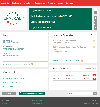Uralkali Announces IFRS 2017 Financial Results

Uralkali (“the Company”, Moscow Exchange: URKA), one of the world’s largest potash producers, today published its financial statements for 2017 prepared in accordance with IFRS, audited by ZAO Deloitte & Touche CIS and approved by the Company’s Board of Directors.
FY2017 FINANCIAL HIGHLIGHTS1:
- Revenue up 21% y-o-y to US$ 2,761 million
- Net revenue2 up 18% y-o-y to US$ 2,183 million
- EBITDA3 up 13% y-o-y to US$ 1,340 million
- EBITDA margin4 of 61%
- Net profit of US$ 875 million
- Export5 sales up 16% y-o-y to 10.9 million tonnes of KCl
The Company’s key financial metrics for 2017 and 2016 were as follows:
|
2017 |
2016 |
|
|
Revenue (US$ million) |
2,761 |
2,278 |
|
Net revenue (US$ million) |
2,183 |
1,851 |
|
EBITDA (US$ million) |
1,340 |
1,183 |
|
EBITDA margin |
61% |
64% |
|
Net profit (US$ million) |
875 |
1,427 |
Dmitry Osipov, Uralkali CEO, commented:
The global potash market recovery in 2017 led to an increase in both the y-o-y production and sales of Uralkali which in turn had a positive impact in the Company’s financial results.
The industry’s fundamentals remained stable and we expect the positive market trend to continue throughout 2018.
Financial Review
The Company’s revenue in 2017 totalled US$ 2,761 million owing to an increase in production and export sales.
However, net profit decreased to US$ 875 million mainly due to decrease in gain from foreign exchange differences and revaluation of derivative financial instruments.
As of the end of December 2017, Uralkali’s net debt was US$ 5,371 million, which is equivalent to 4.01x EBITDA for the last 12 months. The average interest rate for the Company’s loan portfolio for the year was 4.46%.
Market Review6
In 2017, the market of potassium chloride was characterised by high demand in the vast majority of regions. At the year-end, demand growth exceeded 6%, reaching a record of 65 million tonnes. New contracts with China and India concluded under favourable conditions contributed to already rising global prices.
During the first half of 2017, the potash market saw a rapid recovery in global sales. In 1H, potash imports increased by 28% compared to 1H 2016.
Like in 2016, potash producers contracted supplies to China and India only in the summer. At the same time, contract prices grew, which gave an additional impetus to the growth of global potash prices, followed by an additional increase in demand. In
Overall, imports of potassium chloride to China increased in 2017 by 10% year-on-year to 7.5 million tonnes.
Potash imports to India grew by more than 18% year-on-year to 4.5 million tonnes, compared to 3.8 million tonnes in 2016. Good weather conditions, higher minimum purchase prices for key crops and a relatively stable rupee exchange rate made a positive contribution to this performance.
In South-East Asia, the palm oil economy and strengthening of local currencies against the US dollar favourably affected the demand for potassium chloride in 2017. According to the results of the reporting year, potash imports rose by about 14% and totalled 10.3 million tonnes.
Potash demand in Europe also showed a year-on-year increase, while in the second half of the year, the appreciation of the euro had a negative impact on the competitive status of exported NPK fertilisers from Europe.
Brazilian imports of potash exceeded the level of the previous year by 4% and reached 9.2 million tonnes against high soybean prices and the stable exchange rate of the real. In other Latin American countries, there was also a strong demand because of the positive dynamics in local agricultural economies.
Total sales of potassium chloride in North America amounted to 10.2 million tonnes, compared to 9.8 million tonnes in 2016.
It is expected that in 2018 the global demand for potash fertilisers will remain high and can vary from 67 to 68 million tonnes. The main factors of robust demand will be the favourable economy of importers, as well as an acceptable level of profitability and growing needs of agricultural producers.
Alexander Terletsky, Uralkali Trading CEO, commented:
The positive trend, which has been observed recently in the global potash market, continues to strengthen. Prices for potash fertilisers are growing on almost all key consumption markets. Thus, in March, 2018, the price of granular MOP in Brazil, one of the largest spot markets, exceeded US$ 300 per tonne on CFR basis7.
From this perspective, we project the price of the forthcoming long-term contract with the Chinese consortium may show double-digit growth in percentage terms compared to previous year’s price.
As a result, the contract with Chinese importers may become an additional growth driver of global demand, which may reach 68 million tonnes in 2018.
Delisting of Uralkali’s shares from Moscow Exchange
On 18 December, 2017 the Annual General Meeting (AGM) of Uralkali’s shareholders resolved to apply for the delisting of the Company’s shares from the Moscow Exchange, which came into force in accordance with the Federal law “On Joint Stock Companies”.
The Company will additionally inform the public of its future actions, including filing an application to delist.
Uralkali (www.uralkali.com) is one of the world’s largest potash producers and exporters. The Company’s assets consist of 5 mines and 7 ore-treatment mills situated in the towns of Berezniki and Solikamsk (Perm Territory, Russia). Uralkali employs ca.11,000 people (in the main production unit). Uralkali’s shares are traded on the Moscow Exchange.
1 The audited consolidated financial statements may be found on Uralkali’s website
http://www.uralkali.com/ru/investors/reporting_and_disclosure/uk_msfo/
2 Net revenue represents revenue net of freight, railway tariffs and transshipment costs
3 EBITDA is calculated as operating profit plus depreciation and amortisation and does not include one-off expenses
4 EBITDA margin is calculated as EBITDA divided by net revenue
5 According to customs statistics of foreign trade of the Russian Federation
6 Sources: Uralkali’s estimates, the IFA data, customs statistics, financial statements of potash producers
7 Source: Argus sectorial agency data


